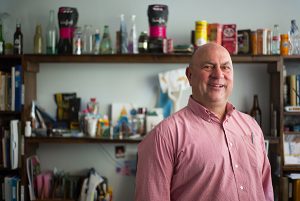
Fritz Yambrach, a professor in the Department of Nutrition, Food Science and Packaging help to develop a way to package water to transport to disaster areas or areas where water is not readily available. (Photo: James Tensuan, ’15 Journalism)
By David Goll
In parts of the world where potable water is difficult to reach and even harder to transport, a San Jose State University professor has devised an invention that could dramatically improve the quality of daily life.
Fritz Yambrach, a professor in the Department of Nutrition, Food Science and Packaging, has developed the Fritz Water Vest, a 10-liter, double-pouch “vest” made of sturdy, multi-layer plastic material that can serve as an alternative to transporting water in heavy buckets, vases or other containers. Such tasks in developing countries are typically handled by women and children. The work can result in injuries to those transporting water-filled containers, which carry up to five gallons, atop their heads.
The vest-like water carrier that can be worn over the head — with the pouches suspended over the chest and back — could also find application in more affluent nations like the United States during emergency situations resulting from floods, fires, earthquakes, tornadoes, hurricanes and other disasters that interrupt the supply and availability of clean water.
Yambrach, who arrived at San Jose State in 2007, is a veteran of the packaging industry, starting his career 40 years ago at the Chrysler automobile company in Michigan. He went on to work in the pharmaceutical and medical device sectors before moving into academia, including at the Rochester Institute of Technology in New York.
Yambrach said he first became aware of the phenomenon of people in impoverished nations having to walk long distances on a daily basis to fetch clean water for drinking and cooking purposes during his childhood. He attended a Catholic elementary school and heard church missionaries talk of seeing women and girls hauling water long distances on their heads.
According to the United Nations, women and girls in sub-Saharan African nations spend 40 billion hours annually collecting water — equivalent to a year’s worth of labor by the entire workforce of France, which numbers about 30 million. Water for the Ages, a blog written by water activist Abigail Brown, estimates the average distance traveled daily by those fetching water in Africa and Asia is 3.7 miles. Brown said water carriers can suffer severe neck and spine damage from toting heavy, inflexible water containers.
Yambrach said he has tried to take everything into account in designing his life-saving vest.
“The construction of the vest makes it very robust,” Yambrach said, noting the edges of the vest are heat-sealed to make it leakproof. “We have even included an additive in the material to inhibit microbial growth,” he said.
The vest is being beta tested in the African nations of Ethiopia and Burundi, as well as Haiti and the Dominican Republic in the Caribbean region.
Manufacturing of the vest is being overseen by Heritage Packaging of Victor, N.Y. News of Yambrach’s invention has attracted the attention of former colleagues and students. One of those is Eric Steigelman, a student in Yambrach’s packaging science class at the Rochester Institute of Technology in 2006. Now a San Diego-based entrepreneur, Steigelman is handling marketing of the vest and the beta-testing projects.
“I am helping the organization find strategic partnerships,” Steigelman said, adding that he hopes to partner with larger companies to “leverage their strengths in funding and distribution. The beauty of this solution is that it is so intuitive. It doesn’t require a lot of instruction or direction. It can help millions of people who struggle every day with water issues, or temporarily because of an emergency.”
Steigelman said one such situation here in the U.S. that has occurred to him as an opportunity for the water vest is the contaminated water crisis in Flint, Mich., where cost-cutting measures by state officials led to the city’s water supply becoming polluted with lead and other toxins.
“The worldwide problem is so big and broad, you need a simple, inexpensive solution to have any chance of success,” he said. “Whether it is a daily need or an emergency, the water vest is a really effective solution.”
